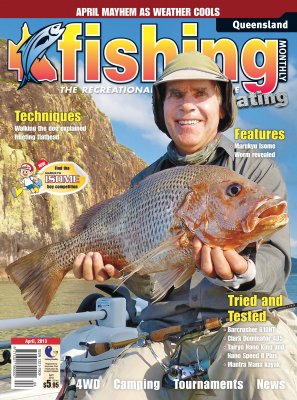Walking the dog with stickbaits by Kim Bain
 The luring technique known as 'walking the dog' refers to the retrieve cadence that generates the unique gliding, side to side, zigzag action normally associated with cylindrical-shaped surface stickbaits. The stickbait is a lure with which the angler has a large part to play in the action that appears out there in front of the fish. A stickbait can be fished super slow, or you can dial it up and crank it fast.
The luring technique known as 'walking the dog' refers to the retrieve cadence that generates the unique gliding, side to side, zigzag action normally associated with cylindrical-shaped surface stickbaits. The stickbait is a lure with which the angler has a large part to play in the action that appears out there in front of the fish. A stickbait can be fished super slow, or you can dial it up and crank it fast.
My take on the walk the dog technique is that it causes maximum movement and disturbance on the water's surface without moving the lure as far forward as other techniques. In this way the lure stays in the strike zone for longer, but still calls fish in from afar. Because the lure moves sideways and then back again, rather than forwards, then when a fish is called in from over yonder, the lure is still there when the hungry predator arrives.
LURE CHOICE
There are three types of stickbait:
1/ those with a curved belly;
2/ those that sit flat in the water;
3/ the ones that hang tail-down.
All three variants can be used with the walk the dog technique. My suggestion is that you should have all three in your tackle box, however you'll find that the lures that lay flat in the water give you the most flexible retrieve options.
Lures that float flat at rest are more likely to glide out to each side at 90 degrees to the line. In fact, if you flick the rod tip back towards the lure after the 'twitch', then you can give the lure enough slack line to turn back at an angle greater than 90 degrees. Masters of the art can sit these well balanced lures in the one spot and walk them from side to side without touching the reel handle. As a party trick they'll do it with one hand behind their back.
Tail heavy lures don't turn out away from the main line as much; therefore they are suited to faster, more constant retrieves.
GET SET FOR SUCCESS
To set yourself up for success, start with the lure. Firstly tune your lure(s) to sit flat in the water. Accordingly, if you are upgrading trebles to heavier 'barra' grade hooks, then select a very buoyant lure and study how it reacts as you load it up. You may choose to run only two hooks on a lure that has three hook hangers in order to keep the extra weight to a minimum.
Keep in mind that lures will be more buoyant in salt water.
A snap swivel may balance out the lure or it may cause it to be nose heavy and cause it to dive under water (especially in freshwater) rather than glide on the surface. Most aficionados prefer loop knots.
Too heavy a leader will restrict the action of your lure. For barramundi and other fish that often demand a heavy and durable leader then choose a lure that can handle it. Lighter leaders generally allow smaller lures to glide better. Ideally the line that you use will float on the surface. For most Australian fishing situations, this means using braid as you